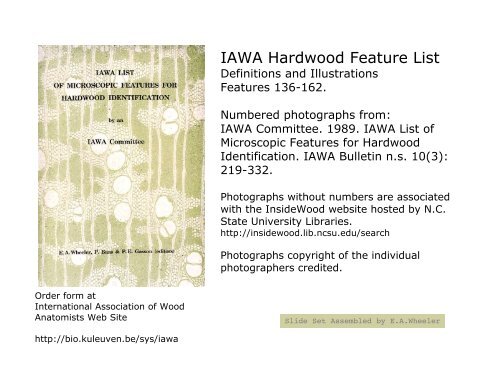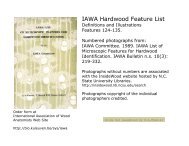IAWA Hardwood Feature List - Inside Wood - Search the Inside ...
IAWA Hardwood Feature List - Inside Wood - Search the Inside ...
IAWA Hardwood Feature List - Inside Wood - Search the Inside ...
You also want an ePaper? Increase the reach of your titles
YUMPU automatically turns print PDFs into web optimized ePapers that Google loves.
Order form at<br />
International Association of <strong>Wood</strong><br />
Anatomists Web Site<br />
http://bio.kuleuven.be/sys/iawa<br />
<strong>IAWA</strong> <strong>Hardwood</strong> <strong>Feature</strong> <strong>List</strong><br />
Definitions and Illustrations<br />
<strong>Feature</strong>s 136-162.<br />
Numbered photographs from:<br />
<strong>IAWA</strong> Committee. 1989. <strong>IAWA</strong> <strong>List</strong> of<br />
Microscopic <strong>Feature</strong>s for <strong>Hardwood</strong><br />
Identification. <strong>IAWA</strong> Bulletin n.s. 10(3):<br />
219-332.<br />
Photographs without numbers are associated<br />
with <strong>the</strong> <strong>Inside</strong><strong>Wood</strong> website hosted by N.C.<br />
State University Libraries.<br />
http://insidewood.lib.ncsu.edu/search<br />
Photographs copyright of <strong>the</strong> individual<br />
photographers credited.<br />
Slide Set Assembled by E.A.Wheeler
MINERAL INCLUSIONS<br />
Prismatic crystals = solitary<br />
rhombohedral or octahedral crystals<br />
composed of calcium oxalate, which are<br />
birefringent under polarized light.<br />
Synonym: rhomboidal crystal.<br />
Chambered cell = an axial parenchyma<br />
strand cell or ray parenchyma cell<br />
subdivided by septa or by thin to thick<br />
end walls.
<strong>Feature</strong> 136. Prismatic crystals present<br />
<strong>Feature</strong> 137. Prismatic crystals in upright<br />
and/or square ray cells.<br />
Drypetes keyensis: E.A. Wheeler<br />
(Putranjavaceae)<br />
Astronium graveolens: E.A. Wheeler<br />
(Anacardiaceae)<br />
Celtis ehrenbergiana: E.A. Wheeler<br />
(Cannabaceae)
<strong>Feature</strong> 138. Prismatic<br />
crystals in procumbent ray<br />
cells.<br />
Capparis flexuosa: E.A. Wheeler<br />
(Capparaceae)<br />
<strong>Feature</strong> 139. Prismatic<br />
crystals in radial alignment<br />
in procumbent ray cells.<br />
Anogeissus latifolia: K. Ogata<br />
(Combretaceae)
<strong>Feature</strong>s 137 & 138. Prismatic<br />
crystals in upright/square<br />
and procumbent ray cells.<br />
Diospyros montana: F. Lens<br />
(Ebenaceae)<br />
<strong>Feature</strong> 138. Prismatic<br />
crystals in procumbent ray<br />
cells.<br />
Gymnostoma papuana: E.A. Wheeler<br />
(Casuarinaceae)
<strong>Feature</strong> 140. Prismatic crystals in chambered<br />
upright and/or square ray cells.<br />
Elaeocarpus calomala P.E. Gasson<br />
(Elaeocarpaceae)<br />
Ahernia glandulosa R.B. Miller<br />
(Achariaceae)
<strong>Feature</strong> 141. Prismatic<br />
crystals in nonchambered<br />
axial parenchyma cells.<br />
Drypetes gerrardii P.E. Gasson<br />
(Putranjavaceae)<br />
<strong>Feature</strong> 142. Prismatic<br />
crystals in chambered axial<br />
parenchyma cells.<br />
165. Lithocarpus edulis. (Fagaceae).<br />
166. Parkia pendula (Leguminosae-Mimosoideae)<br />
P.E. Gasson
<strong>Feature</strong> 142. Prismatic crystals<br />
in chambered axial parenchyma<br />
cells.<br />
Savia bahamensis<br />
(Phyllanthaceae)<br />
E.A. Wheeler<br />
Malpighia incana P.E. Gasson<br />
(Malpighiaceae)<br />
<strong>Feature</strong> 143.<br />
Prismatic crystals<br />
in fibres.<br />
Banara regia P.E. Gasson<br />
(Salicaceae)
<strong>Feature</strong> 144. Druses present = a compound crystal, more<br />
or less spherical in shape, in which <strong>the</strong> many component<br />
crystals protrude from <strong>the</strong> surface giving <strong>the</strong> whole<br />
structure a star-shaped appearance.<br />
<strong>Feature</strong> 145. Druses in ray parenchyma cells<br />
<strong>Feature</strong> 146. Druses in axial parenchyma cells<br />
Hibiscus tiliaceus (Malvaceae)<br />
Druse in ray parenchyma cell.<br />
<strong>Feature</strong>s 144, 145. E.A. Wheeler<br />
Terminalia catappa. (Combretaceae)<br />
Druse in axial parenchyma cell.<br />
<strong>Feature</strong>s 144, 146. D. Grosser
<strong>Feature</strong> 147.<br />
Druses in fibres<br />
(not shown)<br />
<strong>Feature</strong> 148.<br />
Druses in<br />
chambered cells<br />
Banara regia. (Salicaceae)<br />
Druses in chambered ray parenchyma cells.<br />
<strong>Feature</strong>s 144, 145, 148 present.<br />
P.E. Gasson
OTHER CRYSTAL TYPES<br />
<strong>Feature</strong> 149. Raphides = a bundle of long needle-like<br />
crystals.<br />
Vitis vinifera (Vitaceae) P.E. Gasson
<strong>Feature</strong> 150. Acicular crystals = small<br />
needle-like crystals, not occurring in<br />
bundles.<br />
Gmelina arborea (Verbenaceae) D. Grosser
<strong>Feature</strong> 151. Styloids and/or elongate crystals.<br />
Styloids = large<br />
crystals at least<br />
four times as<br />
long as broad<br />
with pointed or<br />
square ends.<br />
Elongate crystals<br />
= crystals two to<br />
four times as long<br />
as broad with<br />
pointed or square<br />
ends.<br />
Memecylon membranifolium<br />
(Melastomataceae)<br />
Styloids in included phloem<br />
Van Vliet 1981. Blumea.<br />
Ligustrum vulgare (Oleaceae)<br />
Baas et al. 1988. <strong>IAWA</strong> Bull.
<strong>Feature</strong> 151. Styloids and/or elongate crystals.<br />
Lophopetalum obtusifolium
<strong>Feature</strong> 152.<br />
Crystals of<br />
o<strong>the</strong>r shapes<br />
(mostly small) =<br />
includes all<br />
o<strong>the</strong>r shapes of<br />
crystals, e.g.,<br />
cubic, navicular<br />
(boat-shaped),<br />
spindle-shaped,<br />
pyramidal,<br />
tabular,<br />
indented,<br />
twinned, etc.<br />
Small cubic crystals. Aporusa villosa<br />
(Phyllanthaceae) P.E. Gasson<br />
Small navicular crystals. Litsea reticulata<br />
(Lauraceae) D. Grosser
<strong>Feature</strong> 153. Crystal sand = a granular mass<br />
composed of very small crystals.<br />
Synonym: microcrystals.<br />
Cordia sebestena<br />
(Boraginaceae)<br />
E.A. Wheeler<br />
Cordia subcaudata (Boraginaceae)<br />
P.E. Gasson<br />
Nothocestrum (Solanaceae)<br />
S. Carlquist
OTHER DIAGNOSTIC CRYSTAL FEATURES<br />
Garcinia latissima (Clusiaceae)<br />
K. Ogata<br />
<strong>Feature</strong> 154. More<br />
than one crystal of<br />
about <strong>the</strong> same size<br />
per cell or chamber.<br />
Bouea oppositifolia (Anacardiaceae)<br />
P.E. Gasson
<strong>Feature</strong> 155. Two<br />
distinct sizes of<br />
crystals per cell or<br />
chamber (below)<br />
Cordia bantamensis (Boraginaceae)<br />
P.E. Gasson<br />
Fig.182. Different size classes<br />
of crystals intergrading in<br />
some ray cells (feature 155<br />
variable), but more than one<br />
crystal of about <strong>the</strong> same size<br />
per cell in o<strong>the</strong>rs (feature 154<br />
present).<br />
155V<br />
154<br />
Cordia abyssinica (Boraginaceae)<br />
P.E. Gasson
<strong>Feature</strong> 156. Crystals in enlarged cells (idioblasts)<br />
Ulmus crassifolia: E.A. Wheeler<br />
(Ulmaceae)<br />
Citrus aurantium (Rutaceae)<br />
Tangential: E.A. Wheeler<br />
Radial: P. Baas
<strong>Feature</strong> 158. Cystoliths<br />
= internal stalked<br />
outgrowths of <strong>the</strong> cell wall<br />
that project in <strong>the</strong> cell<br />
lumen and are composed of<br />
cellulose impregnated with<br />
calcium carbonate. They are<br />
irregular in shape and<br />
sometimes completely fill a<br />
cell.<br />
<strong>Feature</strong> 157. Crystals<br />
in tyloses<br />
Cordia gharaf (Boraginaceae)<br />
Gottwald 1983. <strong>IAWA</strong> Bulletin<br />
Trichan<strong>the</strong>ra gigantea<br />
(Acanthaceae) Ter Welle 1980. <strong>IAWA</strong><br />
Bulletin
Silica bodies = spheroidal or irregularly<br />
shaped particles composed of silicon dioxide.<br />
Synonyms: silica grains, silica inclusions.<br />
<strong>Feature</strong> 159. Silica bodies present<br />
<strong>Feature</strong> 160. Silica bodies in ray cells<br />
Shorea lamellata (Dipterocarpaceae)<br />
R.B. Miller<br />
Sclerolobium guianense<br />
(Leguminosae-Caesalpinioideae)<br />
P.E. Gasson<br />
Clavija lancifolia<br />
(Theophrastaceae)<br />
F. Lens
<strong>Feature</strong> 161. Silica<br />
bodies in axial<br />
parenchyma cells<br />
Apuleia leiocarpa (Leguminosae-<br />
Caesalpinioideae) R.B. Miller<br />
Silica bodies also in ray cells<br />
<strong>Feature</strong> 162. Silica<br />
bodies in fibres<br />
Ocotea cf. puberula (Lauraceae)<br />
P.E. Gasson



